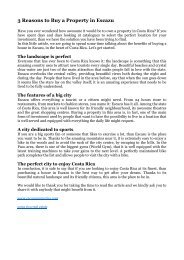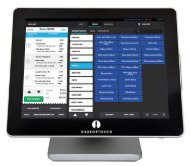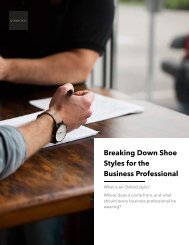You also want an ePaper? Increase the reach of your titles
YUMPU automatically turns print PDFs into web optimized ePapers that Google loves.
Breaking Down <strong>Shoe</strong><br />
<strong>Styles</strong> <strong>for</strong> <strong>the</strong><br />
<strong>Business</strong> <strong>Professional</strong><br />
What is an Ox<strong>for</strong>d style?<br />
Where does it come from, and what<br />
should every business professional be<br />
wearing?
Breaking Down <strong>Shoe</strong> <strong>Styles</strong> <strong>for</strong> <strong>the</strong> <strong>Business</strong> <strong>Professional</strong><br />
21st Mar 2018<br />
You know <strong>the</strong> difference between heels and flats, and you're fairly certain you could pick a pump<br />
out of a line-up of mules.<br />
Even <strong>the</strong> savviest stylist can get tripped up when it comes to business dress shoes, though. If you<br />
think wingtips are a catch-all <strong>for</strong> tailored dress shoes, you're missing out on a lot of nuance and<br />
history.<br />
From loafers to moccasins, Ox<strong>for</strong>ds to Derbies, discover <strong>the</strong> details you're missing with on your<br />
feet.<br />
Women's trends are borrowing from menswear – so know what you want be<strong>for</strong>e you shop!<br />
A Brogue is a low-heeled shoe or boot defined by <strong>the</strong><br />
per<strong>for</strong>ated decorations (brogueing) along <strong>the</strong> wing tip and <strong>the</strong><br />
toe cap.<br />
It's a dress shoe style but can be a bit more casual when<br />
created with a chunkier sole.Ox<strong>for</strong>ds are a <strong>for</strong>mal dress shoe,<br />
typically made from lea<strong>the</strong>r, with a flat sole and slightly raised<br />
heel.<br />
While <strong>the</strong> sole may be hard lea<strong>the</strong>r, slip-proof rubber is<br />
becoming more common, or a combination of <strong>the</strong> two.<br />
An Ox<strong>for</strong>d has a "closed front" – stitching anchoring <strong>the</strong> bottom of<br />
<strong>the</strong> closure panels to <strong>the</strong> upper - which gives it a sleeker, more<br />
<strong>for</strong>mal appearance.<br />
Derby shoes are very similar to Ox<strong>for</strong>ds – in fact, many people<br />
don't notice <strong>the</strong> detailed differences between <strong>the</strong> two. The closure<br />
of a Derby isn't stitched, but open, instead.<br />
Ox<strong>for</strong>d shoes originated at, you guessed it, Ox<strong>for</strong>d College in<br />
England.<br />
The tradition holds that <strong>the</strong> name derived from an easier-to-wear<br />
adaptation of <strong>the</strong> Oxonian, a half-boot with side slits popular at<br />
Ox<strong>for</strong>d University in <strong>the</strong> 1800s.<br />
The slimmer profile shoes were adopted by Ox<strong>for</strong>d University<br />
students in a sartorial rebellion against <strong>the</strong> more restrictive boots<br />
of <strong>the</strong> time.
Traditionally <strong>the</strong> Ox<strong>for</strong>d shoe came with a plain toe cap, which can still be purchased today;<br />
however, Ox<strong>for</strong>ds may be decorated with brogue detailing (known as a semi-brogue) or even<br />
come with a wingtip and more detailed punching (known as a full brogue).<br />
Ox<strong>for</strong>ds don't necessarily need laces - a casual, lace-less option is growing in popularity,<br />
especially <strong>for</strong> summer.<br />
Derby shoes originated in <strong>the</strong> 1850s as a hunting or sporting boot.<br />
By <strong>the</strong> turn of <strong>the</strong> 20th century, Derby shoes moved from <strong>the</strong> pitch to <strong>the</strong> city, becoming <strong>the</strong><br />
preferred footwear <strong>for</strong> men about town.<br />
The fundamental difference between Ox<strong>for</strong>ds and Derbies is <strong>the</strong> closed foot style.<br />
Derby shoes may be worn by those with a wider foot, as <strong>the</strong> lack of seams across <strong>the</strong> upper<br />
allows <strong>the</strong> shoe to expand to fit.<br />
Loafers are almost a play off a sloppy Ox<strong>for</strong>d<br />
style. Similar in overall appearance to brogues,<br />
Ox<strong>for</strong>ds, and derby shoes, Loafers have no<br />
laces, allowing <strong>the</strong>m to slip easily on and off<br />
<strong>the</strong> foot.<br />
You may see <strong>the</strong> uppers of a lea<strong>the</strong>r or suede<br />
loafer embellished with a buckle, metal<br />
studding, or braided lea<strong>the</strong>r.<br />
Some shoemakers will add small elastic panels<br />
under <strong>the</strong> tongue of <strong>the</strong> Loafer, allowing an<br />
even wider foot to fit com<strong>for</strong>tably.<br />
A Loafer looks similar to an Ox<strong>for</strong>ds lacing,<br />
features a more moccasin-like construction,<br />
and is also widely referred to as a slip-on<br />
shoe.<br />
The difference between a Moccasin and a<br />
Loafer is how <strong>the</strong> shoe is constructed.<br />
While both are slip-on styles,<br />
<strong>the</strong> Moccasin's sole and sides made of a single lea<strong>the</strong>r piece which is stitched toge<strong>the</strong>r at <strong>the</strong> top.<br />
On <strong>the</strong> o<strong>the</strong>r hand, loafers are flat shoes which have no laces. A Loafer is made from several<br />
lea<strong>the</strong>r pieces. Moccasins are created from soft lea<strong>the</strong>r, and even <strong>the</strong> soles are softer than <strong>the</strong><br />
traditional hard lea<strong>the</strong>r of a loafer.<br />
Now that you know which style of shoe is which, let's go shopping !
















